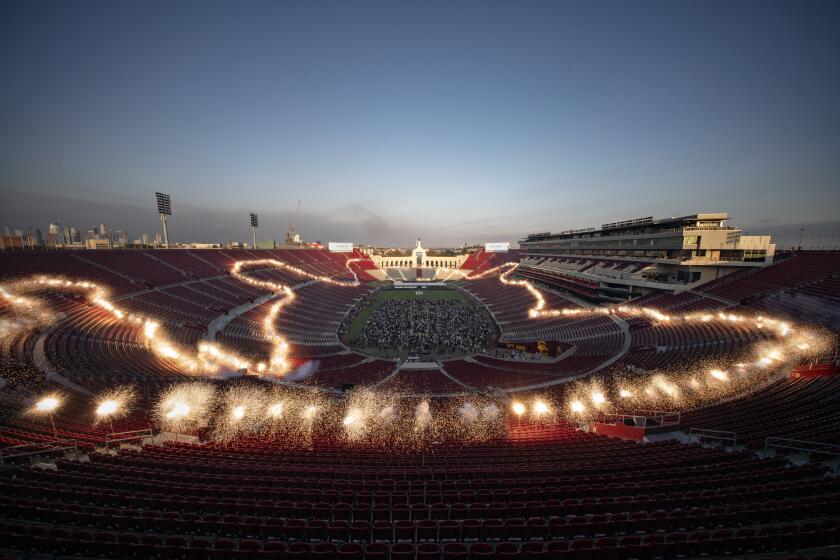The Nation : The Heritage Foundation Takes the Fight Over the Arts to Ignorant New Levels : Censorship: The conservative think-tank has issued a stupifyingly dumb report on restrictions on government arts grants.
The politically motivated quarrels over artistic censorship during the past two years may have left the front pages, but they’re far from over. At least one prominent Washington think-tank has decided to capitalize on the furor, apparently hoping to formalize the previously ad hoc brawl.
The Heritage Foundation, which provided much of the ideological ammunition successfully deployed by the Reagan Administration, has added a “cultural policy studies office” to its operation. Specializing in economic and defense issues throughout the 1980s, Heritage made its name as a persuasive right-wing alternative to what were regarded as entrenched liberal think-tanks.
Now, it has moved toward seizing topics many feel will be crucial to the 1990s. Broadsides on a variety of cultural subjects will be issued to Congress, the White House and anyone else who will listen.
What will these eager listeners hear? Judging from its initial effort to set the agenda of artistic debate, they will hear the Heritage Foundation’s new culture office sinking like a stone into the icy waters of the Potomac. “Stupefyingly dumb” wouldn’t be too bold a description of the 27-pages of treacle recently issued.
Imagine an economic study conducted by someone who can’t balance a checkbook, or a paper on national defense written by the average 8-year-old, and you’ll have some idea how utterly doltish is the Heritage missive on the National Endowment for the Arts. Peppered with inflammatory errors of fact, dependent on laughable citations from dubious “experts” and replete with jargon its author clearly doesn’t understand, it wouldn’t pass muster as an undergraduate term paper at an obscure junior college.
Unless, of course, obscure junior colleges now accept as scholarly footnotes references drawn from Spy magazine, as this Heritage report solemnly does. The satirical monthly’s “How the NEA Really Works” is actually cited with a straight face.
The Heritage report backs government censorship of the arts (the euphemism of choice is “minimal content restrictions”). To demonstrate the need, the NEA is condemned for “bankrolling” a “former pornographic movie star,” for arrogantly refusing to turn over for private review “the (grant) application of artist Mike Kelley,” which NEA Chairman John Frohnmayer is said to have vetoed, and for systematic discrimination in denying funds to “current artists who produce representational art.”
Not one charge is accurate. The NEA has never given a grant to a porn star, past or present. As for Kelley, he didn’t submit a grant application. (Maybe Heritage means the application from a respected Boston museum that is planning a survey of Kelley’s work.) And representational art is regularly funded. To cite a rather obvious example: The photographs of Robert Mapplethorpe may be controversial, but they’re certainly representational art. So, for that matter, is Kelley’s.
Sloppiness is one thing, but these achingly simple errors of fact suggest more than an author with little intimate grasp of his subject--although they do that, too. The report, incidentally, was written by Heritage senior fellow Robert H. Knight. The mistakes conspire to produce a wildly caricatured image, rather than a likeness with any claim on accuracy.
Caricature, of course, is more useful to the Heritage program. Five years ago, political analyst Sidney Blumenthal of the New Republic provided a clue as to why when he wrote: “Heritage wants liberalism to tender an unconditional surrender.” The first report from its office of cultural policy studies is plainly guided by a conviction that the NEA and its principal constituency--namely, artists--comprise a recalcitrant nest of liberals within the conservative policy establishment. Heritage wants a rout, by whatever means.
The means are these: Distort for effect, and cast the war against liberalism in terms used in the arts--at least, in terms Heritage supposes are used in the arts. Therein lies the unwitting comedy of the screed.
Leading the cartoon list of “serious problems” claimed to bedevil the NEA is the agency’s so-called “bias against traditional forms of art.” The NEA is charged with having instead “consistently favored the avant-garde--defined by Webster’s Third New International Unabridged Dictionary as: ‘Those who create, produce or apply new, original or experimental ideas, designs, techniques.’ ”
In the Heritage opera bouffe , the villainous part of the avant-garde is implicitly played by liberals, while conservatives assume the innocent role of traditional, or representational, artists. That’s why Mapplethorpe’s more sexually explicit photographs, which clearly represent inescapable aspects of contemporary society, aren’t what come to Robert Knight’s mind when he makes his absurd claim that “current artists who produce representational art” are routinely discriminated against by the federal agency. What he really means is that government funded art should represent only conservative pieties.
I suppose we should be thankful the broadside has moved on from citations in Spy magazine to quotations plucked from Webster’s. But don’t take too much solace. Webster’s account hasn’t much to do with any historical reality of art’s avant-garde. Using a popular dictionary definition is simply necessary to the report’s obfuscating task.
After all, there’s nowhere else to turn. Even among serious art critics within its own ideological camp, scant comfort will likely be found for an idiotic proposition of a war between traditional artists and the avant-garde. You see, the avant-garde has been dead and buried for a generation.
“My own view of the matter,” writes Hilton Kramer, the country’s leading art critic of a neo-conservative persuasion and darling of pro-censorship types, “is that the Age of the Avant-Garde has definitely passed.”
This declaration, widely shared by critics of divergent political stripes, is hardly a bulletin from the front. Kramer made it in 1972. Indeed, it was the subject of his first book, which simply pointed out that, after a century of justified acclaim, the avant-garde had become tradition. As it’s impolite to speak ill of the dead, someone really ought to notify the Heritage Foundation of the avant-garde’s demise.
Maybe Kramer will give them a call. On second thought, maybe not. Even he must know this report is an intellectual fraud. Heritage has other fish to fry, and a trumped up battle between a government-coddled “avant-garde” and the beleaguered minions of “traditional art” is merely a theatrical tool in that larger effort.
As with traditional farce, the Heritage report reaches dizzying heights of lunacy: Extensively quoted as authorities are James Cooper and Richard Lack--obscure artists cum critics in New York and Minneapolis, respectively, who share a belief in the continuing vitality of the 18th-Century aesthetic of Neoclassical painting. These people are to the discipline of art what the Flat Earth Society is to science.Yet, the unfunded duo are offered as tacit victims of the NEA’s discriminatory practices. In a riotous (if unintended) burlesque worthy of cut-rate Moliere, the aberrant fringe is hailed by the Heritage Foundation as the aggrieved mainstream.
It’s easy to forget that this Orwellian double-think is deadly serious. Heritage is not joking. In demanding a conservative litmus test for programs funded by the National Endowment for the Arts, its new office for cultural policy studies has put political fealty at the top of its arts agenda. It’s hard to imagine a more profound statement of contempt for democracy. When the laughter stops, the chill starts.
More to Read
The biggest entertainment stories
Get our big stories about Hollywood, film, television, music, arts, culture and more right in your inbox as soon as they publish.
You may occasionally receive promotional content from the Los Angeles Times.











